| Listing 1 - 10 of 12 | << page >> |
Sort by
|
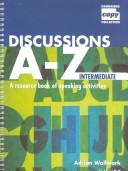
ISBN: 0521559812 9780521168090 0521559790 0521559782 9780521132855 9780521559812 9780521559799 Year: 1997 Publisher: Cambridge: Cambridge university press,
Abstract | Keywords | Export | Availability | Bookmark
 Loading...
Loading...Choose an application
- Reference Manager
- EndNote
- RefWorks (Direct export to RefWorks)
dit boek hoort een audiocassette, vragen aan de balie !!!
English language --- Spoken English --- Anglais (Langue) --- Spoken English. --- Textbooks for foreign speakers. --- Anglais parlé --- Manuels pour allophones --- Engels --- Taalgebruik --- Oefeningen --- Taal --- enge 485.2 --- Non music recording --- Oefening --- Therapie --- Kleuter --- Geschiedenis --- Spraaktechnologie --- English language - Spoken English - Problems, exercises, etc --- English language - Textbooks for foreign speakers --- English language - Spoken English
Book
ISBN: 9780748625307 9780748625291 0748625291 0748625305 9780748625219 9786611357597 0748651543 1281357596 0748630880 9780748630882 9781281357595 6611357599 Year: 2008 Publisher: Edinburgh : Edinburgh University Press,
Abstract | Keywords | Export | Availability | Bookmark
 Loading...
Loading...Choose an application
- Reference Manager
- EndNote
- RefWorks (Direct export to RefWorks)
An accessible overview of the state of current knowledge about English as it is spoken in New Zealand.
English language --- Spoken English --- Variation --- History --- English language. --- English Language --- English --- Languages & Literatures --- Germanic languages --- Phonology --- English language - Spoken English - New Zealand --- English language - Variation - New Zealand --- English language - New Zealand --- English language - New Zealand - History --- Anglais (langue) --- Nouvelle Zélande
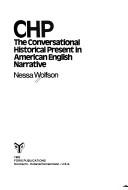
ISBN: 3110851695 9783110851694 9783110133592 3110133598 9070176602 9789070176600 9070176610 9789070176617 3110133601 Year: 1982 Volume: 1 Publisher: Dordrecht, Holland ; Cinnaminson, U.S.A. : Foris Publications,
Abstract | Keywords | Export | Availability | Bookmark
 Loading...
Loading...Choose an application
- Reference Manager
- EndNote
- RefWorks (Direct export to RefWorks)
No detailed description available for "CHP".
English language --- Narration (Rhetoric) --- Narrative (Rhetoric) --- Narrative writing --- Rhetoric --- Discourse analysis, Narrative --- Narratees (Rhetoric) --- Germanic languages --- Tense. --- Spoken English --- Verb --- English language - Tense --- English language - Spoken English - United States --- English language - United States - Tense
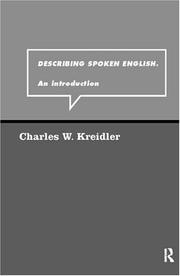
ISBN: 0415150949 0415150957 113474708X 1280328460 0203278577 9780203278574 9786610328468 1134747071 0203135016 9780415150958 Year: 1997 Publisher: London ; New York : Routledge,
Abstract | Keywords | Export | Availability | Bookmark
 Loading...
Loading...Choose an application
- Reference Manager
- EndNote
- RefWorks (Direct export to RefWorks)
Describing Spoken English provides a practical and descriptive introduction to the pronunciation of contemporary English. It presumes no prior knowledge of phonetics and phonology.Charles Kreidler describes the principal varieties of English in the world today. Whilst concentrating on the phonological elements they share, the author sets out specific differences as minor variations on a theme. Although theoretically orientated towards generative phonology, theory is minimal and the book is clear, comprehensive and accessible to undergraduate and postgraduate students of linguistic
Phonetics --- English language --- Anglais (Langue) --- Spoken English --- Variation --- Phonology --- Anglais parlé --- Phonologie --- Linguistics --- -English language --- -Linguistics --- Linguistic science --- Science of language --- Language and languages --- Germanic languages --- Languages. --- English Language --- English --- Languages & Literatures --- Spoken English. --- Variation. --- Linguistics. --- Anglais parlé --- Colloquial English --- Dialects --- Phonology. --- English language. --- English language - Spoken English --- English language - Variation
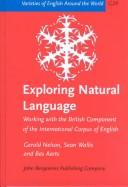
ISBN: 9027248893 9027248885 1588112705 9786613358318 128335831X 9027275351 9789027248893 9789027275356 6613358312 9781283358316 9789027248886 9781588112705 1588112713 9781588112712 Year: 2002 Volume: G29 Publisher: Amsterdam ; Philadelphia : John Benjamins Pub. Co.,
Abstract | Keywords | Export | Availability | Bookmark
 Loading...
Loading...Choose an application
- Reference Manager
- EndNote
- RefWorks (Direct export to RefWorks)
ICE-GB is a 1 million-word corpus of contemporary British English. It is fully parsed, and contains over 83,000 syntactic trees. Together with the dedicated retrieval software, ICECUP, ICE-GB is an unprecedented resource for the study of English syntax.Exploring Natural Language is a comprehensive guide to both corpus and software. It contains a full reference for ICE-GB. The chapters on ICECUP provide complete instructions on the use of the many features of the software, including concordancing, lexical and grammatical searches, sociolinguistic queries, random sampling, and searching for synt
English language --- Computational linguistics. --- Variation --- Spoken English --- Written English --- -English language --- -Computational linguistics --- Automatic language processing --- Language and languages --- Language data processing --- Linguistics --- Natural language processing (Linguistics) --- Applied linguistics --- Cross-language information retrieval --- Mathematical linguistics --- Multilingual computing --- Germanic languages --- -Spoken English --- -Written English --- -Data processing --- Data processing --- Computational linguistics --- English language - Variation - Great Britain. --- English language - Spoken English - Great Britain. --- English language - Written English - Great Britain. --- English language - Great Britain.
Book
ISSN: 21937648 ISBN: 3642274544 3642433081 3642274552 1299197507 Year: 2013 Publisher: New York : Springer,
Abstract | Keywords | Export | Availability | Bookmark
 Loading...
Loading...Choose an application
- Reference Manager
- EndNote
- RefWorks (Direct export to RefWorks)
The monograph constitutes an attempt to demonstrate how Cognitive Grammar (CG) can be employed in the foreign language classroom with a view to aiding learners in better understanding the complexities of English grammar. Its theoretical part provides a brief overview of the main tenets of Cognitive Grammar as well as illustrating how the description of English tense and aspect can be approached from a traditional and a CG perspective. The empirical part reports the findings of an empirical study which aimed to compare the effects of instruction utilizing traditional pedagogic descriptions with those grounded in CG on the explicit an implicit knowledge of the Present Simple and Present Continuous Tenses. The book closes with the discussion of directions for further research when it comes to the application of CG to language pedagogy as well as some pedagogic implications.
English language --Spoken English -- Study and teaching. --- English language --Study and teaching -- Foreign speakers. --- Languages & Literatures --- Philology & Linguistics --- Cognitive grammar. --- English language --- Grammar. --- Tense. --- Aspect. --- Cognitive linguistics --- Verbal aspect --- Analysis and parsing --- Diagraming --- Linguistics. --- Applied linguistics. --- Applied Linguistics. --- Grammar, Comparative and general --- Psycholinguistics --- Verb --- Composition and exercises --- Grammar, Comparative and general. --- Linguistics --- Comparative grammar --- Grammar --- Grammar, Philosophical --- Grammar, Universal --- Language and languages --- Philosophical grammar --- Philology --- Grammar, Comparative
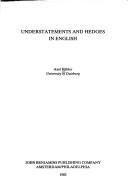
ISBN: 9027225311 9786613359476 1283359472 9027280339 9789027225313 9789027280336 9781283359474 6613359475 Year: 1983 Volume: 4,6 Publisher: Amsterdam ; Philadelphia : J. Benjamins,
Abstract | Keywords | Export | Availability | Bookmark
 Loading...
Loading...Choose an application
- Reference Manager
- EndNote
- RefWorks (Direct export to RefWorks)
The goal of this monograph is a comprehensive analysis of understatements and other forms of non-direct speech (hedges) in modern English. It is based on a multi-level approach, including philosophical, cultural, and socio-psychological arguments. The main part consists of an investigation of the linguistic restrictions for understatements and hedges to be formed by means of the following grammatical categories: negation of predicates, gradation of predicates, modalization of affirmative sentences by means of parenthetical verbs, modal adverbs, modal verbs, and questions.
Figures of speech --- Understatement --- English language --- National characteristics, English --- Spoken English --- Syntax --- Figures of speech. --- National characteristics, English. --- Understatement. --- Spoken English. --- Syntax. --- Pragmatics --- 820.075 --- -English language --- -Figures of speech --- Litotes --- Irony --- English national characteristics --- Imagery --- Speech, Figures of --- Tropes --- Rhetoric --- Symbolism --- Germanic languages --- 820.075 Engelse literatuur--?.075 --- Engelse literatuur--?.075 --- Colloquial English --- Anglais (Langue). Figures. --- Engels. Figuren. --- English language - Spoken English --- English language - Syntax --- Anglais (langue) --- Euphemismes
Book
ISBN: 0773418563 9780773418561 9780773430709 0773430709 Year: 2012 Publisher: Lewiston : The Edwin Mellen Press,
Abstract | Keywords | Export | Availability | Bookmark
 Loading...
Loading...Choose an application
- Reference Manager
- EndNote
- RefWorks (Direct export to RefWorks)
This is the first book to carefully analyze the linguistic conventions associated with Irish English folklore. Other books have studied linguistics in this language variety by studying letters, and all have ignored the use of folklore in constructing language conventions. This is the first book to discuss how peasants played a role in the construction of the Irish English languages.
English language -- 19th century -- History. --- English language -- Foreign elements -- Irish. --- English language -- Ireland -- Grammar. --- English language -- Ireland -- History. --- English language -- Spoken English -- Ireland. --- English language --- Irish language --- Languages in contact --- English --- Languages & Literatures --- English Language --- Areal linguistics --- Erse language --- Gaelic language, Irish --- Irish Gaelic language --- Goidelic languages --- Germanic languages --- History --- Spoken English --- Grammar --- Foreign elements --- Irish --- Influence on English --- Dialects --- Ireland --- Civilization --- Irish Free State
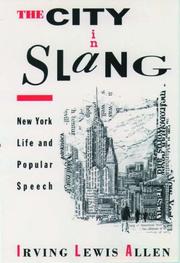
ISBN: 0195092651 0195357760 1429406615 9781429406611 1280527692 9781280527692 9780195075915 0195075919 9780195092653 0195075919 0190282452 Year: 1993 Publisher: New York : Oxford University Press,
Abstract | Keywords | Export | Availability | Bookmark
 Loading...
Loading...Choose an application
- Reference Manager
- EndNote
- RefWorks (Direct export to RefWorks)
The American urban scene, and in particular New York's, has given us a rich cultural legacy of slang words and phrases, a bonanza of popular speech. Hot dog, rush hour, butter-and-egg man, gold digger, shyster, buttinsky, smart aleck, sidewalk superintendent, yellow journalism, breadline, straphanger, tar beach, the Tenderloin, the Great White Way, to do a Brodie--these are just a few of the hundreds of popular words and phrases that were born or took on new meaning in the streets of New York. In The City in Slang, Irving Lewis Allen traces this flowering of popular expressions that accompanied the emergence of the New York metropolis from the early nineteenth century down to the present. This unique account of the cultural and social history of America's greatest city provides ineffect a lexicon of popular speech about city life. With many stories Allen shows how this vocabulary arose from city streets, often interplaying with vaudeville, radio, movies, comics, and the popular songs of Tin Pan Alley. Some terms of great pertinence to city people today have unexpectedly old pedigrees. Rush hour was coined by 1890, for instance, and rubberneck dates to the late 1890s and became popular in New York to describe the busloads of tourists who craned their necks to see the tall buildings and thesights of the Bowery and Chinatown. The Big Apple itself (since 1971 the official nickname of New York) appeared in the 1920s, though first in reference to the city's top racetracks and to Broadway bookings as pinnacles of professional endeavor. Allen also tells fascinating stories behindonce-popular slang that is no longer in use. Spielers, for example, were the little girls in tenement districts who danced ecstatically on the sidewalks to the music of the hurdy-gurdy men and, when they were old enough, frequented the dance halls of the Lower East Side. Following the trail of these words and phrases into the city's East Side, West Side, and all around the town, from Harlem to Wall Street, and into the haunts of its high and low life, The City in Slang is a fascinating look at the rich cultural heritage of language about city life.
English language --- New York (N.Y.) --- Slang --- Social aspects --- Spoken English --- Popular culture --- New York (State) --- Social life and customs --- City and town life --- Terminology --- Americanisms --- Americanisms -- New York (State) -- New York. --- City and town life -- Terminology. --- English language -- New York (State) -- New York -- Slang. --- English language -- Social aspects -- New York (State) -- New York. --- English language -- Spoken English -- New York (State) -- New York. --- New York (N.Y.) -- Social life and customs. --- Popular culture -- New York (State) -- New York. --- Germanic languages --- City life --- Town life --- Urban life --- Sociology, Urban --- Terminology. --- Slang. --- Dialects --- Social life and customs. --- ENGLISH LANGUAGE --- U.S. --- SLANG
Book
ISBN: 9783110376036 3110376032 3110376148 3110394197 9783110394191 9783110376142 Year: 2015 Volume: 557 Publisher: Berlin : De Gruyter,
Abstract | Keywords | Export | Availability | Bookmark
 Loading...
Loading...Choose an application
- Reference Manager
- EndNote
- RefWorks (Direct export to RefWorks)
Parenthesis has recently seen a considerable surge in interest. This volume presents the – often contrasting – theoretical positions on parenthetical verbs and examines them from different analytical perspectives. It covers parenthetical verbs in English as well as in several other languages. Methodologically, the volume is marked by its empirical orientation: Most contributions are based on data from experiments or corpora. Parenthesis has recently seen a considerable surge in interest. This volume presents the – often contrasting – theoretical positions on parenthetical verbs and examines them from different analytical perspectives. The initial theoretical section contains, among others, two contributions presenting diametrically opposed analyses of the syntax of parenthetical verbs. Although (synchronic) syntax pervades the volume, other analytical levels and approaches are also given weight: The second section provides insights into the historical and ontogenetic development of parenthetical verbs, while the third section deals with prosody and prosody-syntax or prosody-semantics mappings. The volume covers parenthetical verbs in English as well as in several other languages (Danish, Dutch, French, German, Portuguese and Turkish), some of which are rarely taken into consideration when dealing with parentheticals. Methodologically, the volume is marked by its strong empirical orientation: With few exceptions, the contributions are based on data from experiments or from corpora (historical, contemporary, diachronic, synchronic, oral, written, child, adult).
Grammar, Comparative and general --- Parenthetical constructions. --- Verbals. --- Verb. --- English language -- Parenthetical constructions. --- English language -- Spoken English. --- English language -- Syntax. --- Grammar, Comparative and general -- Parenthetical constructions. --- Languages & Literatures --- Philology & Linguistics --- Parenthetical constructions --- Verbal phrase --- Comparative grammar --- Grammar --- Grammar, Philosophical --- Grammar, Universal --- Language and languages --- Philosophical grammar --- Linguistics --- Philology --- Parenthesis (Rhetoric) --- Parenthetical constructions (Grammar) --- Rhetoric --- Grammar, Comparative --- Constituent sentence --- Embedded clause --- Inserted clause --- Syntax --- Language and languages. --- Foreign languages --- Languages --- Anthropology --- Communication --- Ethnology --- Information theory --- Meaning (Psychology) --- Verb --- Verb phrase --- Verbals --- Reflexives --- Comment Clauses. --- Discourse Markers. --- Parenthetical Verbs. --- Reporting Clauses.
| Listing 1 - 10 of 12 | << page >> |
Sort by
|

 Search
Search Feedback
Feedback About UniCat
About UniCat  Help
Help News
News